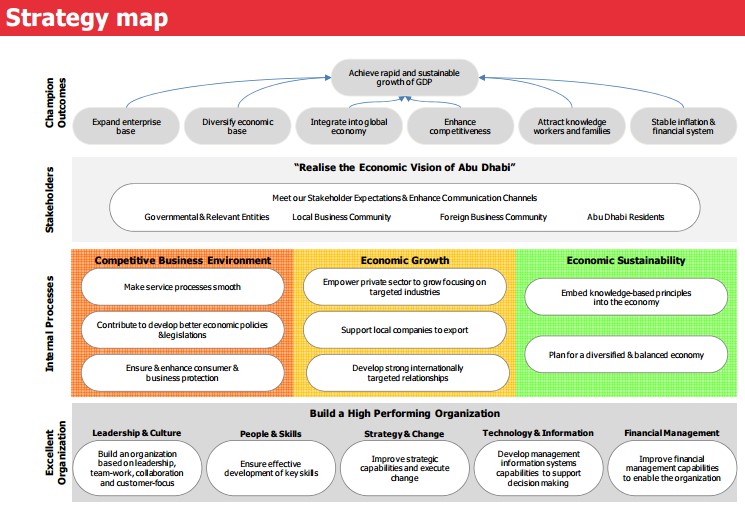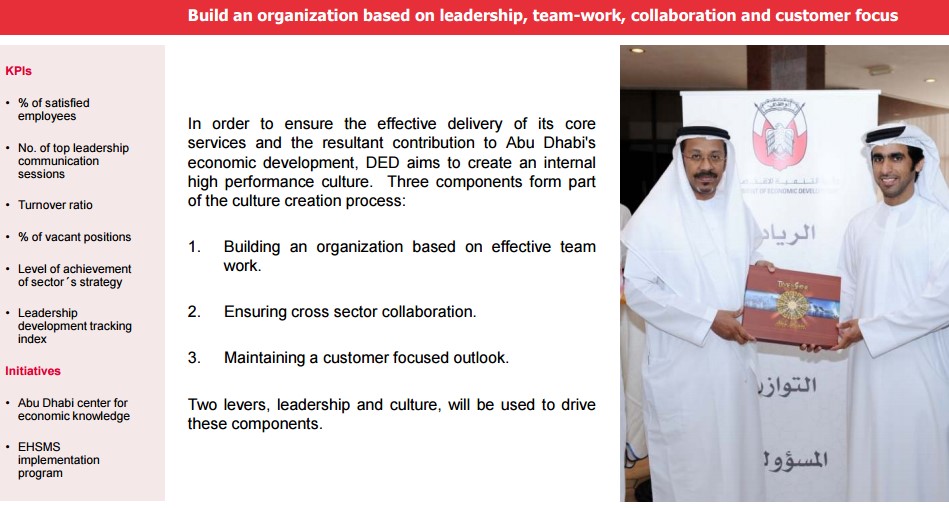Managing performance at the governmental level: the Department of Economic Development – Abu Dhabi

The Department of Economic Development (DED) of Abu Dhabi is a governmental entity “responsible for proposing the economic and commercial policy of Abu Dhabi Emirate and preparing the plans and programmes required for implementing this policy”, as stated by the Abu Dhabi Government.
In 2011, the Abu Dhabi DED has launched their 2011-2015 Strategic Plan, where the department’s strategic directions are established, along with a solid framework meant at measuring and managing their performance towards their attainment.
DED’s organizational identity and purpose are translated into their Vision, Mission and Values, which are clearly formulated and can be found on their official website, as a means of communicating what the department is striving to achieve for to the citizens of Abu Dhabi.
Building on these statements, the 2011-2015 Strategic Plan details the five core functions of the DED:
- Economic planning and research, which includes enhancing the business environment by drafting appropriate economic policies and legislation;
- Economic agenda, policy, and regulation, which has as main elements empowering the public sector by proposing legislation, participating in conferences, as well as negotiating different agreements;
- Promotion of trade and investment, which also includes the promotion of innovation principles into the economy;
- Enterprise and regional development, mainly by supporting the growth of those industrial sectors that support knowledge-based economy;
- Market enablement and supervision, by monitoring activities against defined legislation, as well as by implementing and managing consumer protection processes.
The five main functions of the department are briefly explained in order to ensure that the DED’s contribution and responsibilities are clearly communicated to their stakeholders.
Based on the Vision, Mission and Values, as well as on these core functions, the DED developed the main instrument used to cluster, visualize and communicate their strategic focus for the period 2011 – 2015, the DED Strategy map.
DED’s Strategy Map was built on the four Balanced Scorecard perspectives. As mentioned in the report, the reason behind choosing the Balanced Scorecard approach was the fact that “it provides multiple perspectives to manage strategic priorities, KPIs and initiatives”, as mentioned on their website. Furthermore, the Strategy Map developed at corporate level provided the basis for cascading and developing the performance management framework within DED’s sub-departments.
The Strategy Map of the Abu Dhabi DED consists of a set of objectives grouped, as mentioned before, under the four traditional Balanced Scorecard perspectives: Financial, Customer, Internal Processes and People, Learning and Growth. They were customized to fulfill the need of the organization, resulting in the establishment of the following perspectives:
- Champion Outcomes;
- Stakeholders;
- Internal Processes;
- Excellent Organization.
Each perspectives contains between four and eight objectives. In order to maximize relevance and ensure proper communication and understanding, DED also clustered objectives within each perspective into based on their purpose, as well as on the relationship between objectives. The best example is the Internal Processes perspective which contains three clusters, each consisting of two or three related objectives, as you can observe in the above-illustrated Strategy Map.
DED measures the achievement of organizational objectives through the use of Key Performance Indicators (KPIs), which ensures concentration of the organizational efforts towards achieving the established targets by undertaking initiatives.
As it can be seen in the above picture, each objective is accompanied by a brief description that serves to ensure a clear understanding regarding its purpose. The assigned KPIs and Initiatives are also mentioned for each objective.
As a recommendation for improvement, we can mention the standardization of KPIs’ names (# – Number of, % – Percentage of, $ – Value of), as this approach will ensure a uniform understanding of KPIs across the organization, it will increase efficiency and facilitate communication. Standardized in this manner, DED’s KPIs would be the following:
- % Employee satisfaction
- # Top Leadership communication sessions
- % Turnover ratio
- % Vacant positions
- % Sector targets achieved
- # Leadership development tracking index
Up until this point, the Abu Dhabi Department of Economic Development started on the right foot, by clearly establishing the organizational identity and by cascading these elements in their four-year plan, which includes clear objectives, KPIs and initiatives. Future recommendations for improvement are the development of a Scorecard, that would help the department in keeping track of their objectives through the assigned KPIs, as well as the implementation of a Portfolio of Initiatives, which will help the department make sure its projects are directly linked to the strategic objectives, thus ensuring a proper concentration of efforts towards achieving the strategy.
References:
- Abu Dhabi eGovernment Gateway (2015), Department of Economic Development (DED)
- Department of Economic Development (DED) (2011), Strategic Plan (2011 – 2015)
Image Source:

Tags: Government - State / Federal performance, Performance in UAE, Strategic Performance Management







